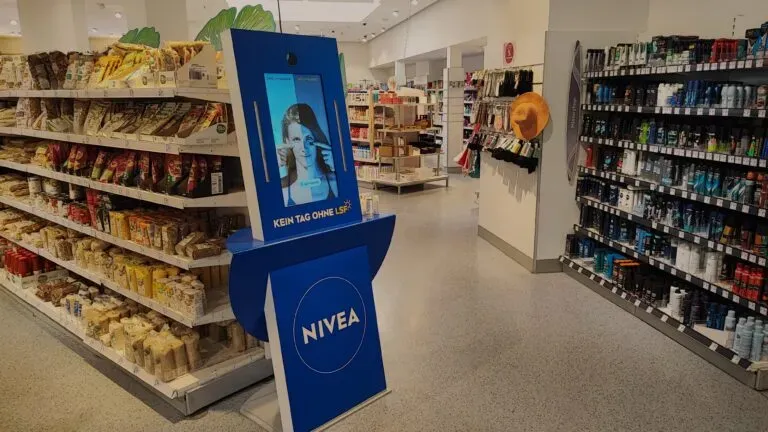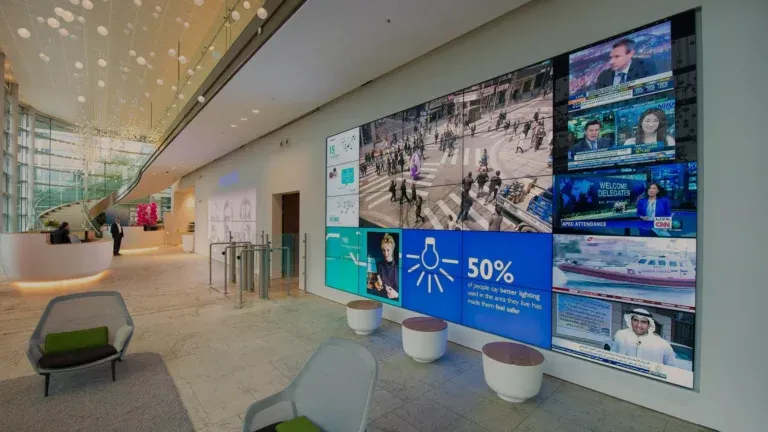Digital Indoor and Outdoor advertising – What’s the difference?
These two forms of DOOH advertising have their characteristics and advantages, which are important to understand for successful promotion of a brand or product compared to static advertising.
Digital indoor advertising
Indoor advertising is targeted at audiences located inside premises, such as shopping malls, cinemas, hotels, restaurants, and office spaces. The main elements of Indoor advertising are advertising screens and video walls, which are placed inside buildings and rooms.
For digital indoor advertising, specialized indoor tv software is used, allowing the management of video and audio materials on indoor screens. Indoor TV players and indoor radio players provide high-quality and uninterrupted content playback.
Digital outdoor advertising
In contrast, outdoor advertising is aimed at those who are outside of premises. These can be billboards, lightboxes, posters, and other advertising structures located on streets, in parks, on vehicles, and public transport.
For digital outdoor advertising, CMS – content management software is used, which allows planning and playback of content on outdoor screens and other external advertising carriers. This solution enables effective digital advertising control and ensures high visibility at any time of the day.
Indoor advertising and its peculiarities
For a better understanding of how this form of advertising works, it’s necessary to know its peculiarities. Usually, marketers choose a target for precise impact on the target audience, setting it to a certain radius around the point of sale. But in advertising campaigns, there is a minimal threshold on distance.
Advertising will cover everyone who is within a 500-meter radius. To this selection, “extra” people who are not representatives of the target audience might be included.
Indoor advertising, placed directly at the point of sale or nearby, will cover fewer people. But they are guaranteed to be potential buyers.
The second peculiarity lies in the impact on a “warm” or “hot” audience. If people have already come to the shopping center, it means they are ready to make purchases. It’s necessary to direct them to the “right” store and call them to action.
Finally, announcements in public premises affect customers always. Unlike internet advertising, they can’t be turned off or marked as spam.
Examples of static indoor advertising:
– Dummies or jumbos. These are objects that fully replicate a recognizable product, but are reproduced in larger sizes. For example, an advertising stand in the shape of a well-known battery could be placed in a home goods store;
– Lightboxes. These are illuminated boxes inside which advertising posters are placed. Thanks to backlighting, lightboxes attract more attention. They are used for advertising new products, promotional offers;
– Mobiles or banners. These are large hanging structures, often used either in shopping centers or in multi-brand stores. Their purpose is to inform visitors about the presence of a certain store/brand in the shopping center. Interested customers are guided by the mobile and head towards the advertised store;
– Shelf talkers. These are small panels that attach to a shelf or merchandise rack. Their task is to draw attention to a specific product – a novelty, promotion, limited collection;
– Wobblers. Another element that attaches to the shelf;
– Stoppers. Vertical dividers. Usually, two dividers are used, between them is the product with one common feature – from the same manufacturer;
– Neck hangers. Advertising equipment used only for bottles. A paper element is placed over the neck, highlighting the product among all others on the shelf;
– Promo stands. These are branded stands for informing visitors to the store or conducting tastings;
– Corners or brand corners. These are separate sales points in a shopping mall, decorated according to the brand’s corporate style;
– Dispensers. Such stands are equipped with pockets. Passersby take brochures, flyers, or other printed advertising materials from them;
– Roll-ups – vertical retractable structures with a fixed poster;
– Table tents. A small structure made of transparent plastic, inside which a flyer is placed.
Some static structures have come into indoor advertising from outdoor advertising. They are rarely used in stores. More often, they are applied in shopping centers to direct visitors to a store. For example, a standee or a panel-mount is used. In both cases, the equipment displays the brand’s logo. The mount is attached to the wall or ceiling, while the standee is placed on the floor. The floor equipment has a larger area, so it can display an offer or promotion conditions.
Features of outdoor advertising as a channel for spreading advertising information
Outdoor advertising media hold a somewhat unique position compared to other advertising mediums. This is linked, primarily, to the fact that the main purpose of the majority of media used as advertising carriers is not the publication of advertisements: press, television, and radio are created and function as socially significant sources of public non-commercial information, for which advertising is an important, but not the main element. On the other hand, outdoor advertising media are exclusively designed for the dissemination of commercial advertising information, which inevitably influences the audience’s attitude towards them: according to many studies, most people consider outdoor advertising (especially street advertising) an irritating factor that significantly worsens the urban landscape. Such an attitude is greatly facilitated by the fact that outdoor advertising cannot be “turned off” or ignored in a similar manner, making contact with it inevitable. Considering such a reaction to pervasive outdoor advertising, advertising concept developers sometimes advise advertisers to use specific, unconventional creative strategies when conducting advertising campaigns.
Indoor advertising and outdoor advertising — combining directions
When developing or planning an advertising campaign, entrepreneurs might get the false impression that they can use only one type of placement. By combining outdoor and indoor forms, it’s possible to cover more potential customers, warm them up, increase product recognition, and gain more profit.
Outdoor advertising should be used to create intrigue. Bright visual effects, simple messages attract the reader’s attention. But then, they should see an indoor carrier to get more information about the product:
– availability of a promotion on the product;
– recommendations for use;
– sales location.
Of course, there’s always a certain budget and limitations. Therefore, it’s necessary to responsibly approach the placement of advertisements to ensure that the spent budget works as efficiently as possible.
The importance of choosing the right solution
The choice between Indoor and Outdoor advertising depends on the campaign’s objectives, target audience, and budget. Indoor advertising is effective for attracting the attention of audiences indoors, while Outdoor advertising can be useful for catching the attention of mass audiences on streets and public spaces.
Regardless of the type of advertising you choose, it’s important to have a proper strategy based on digital advertising media and modern digital signage solutions, where the foundation is content management software. It will give you an advantage over competitors and the ability to create unconventional advertising campaigns.
Ultimately, by combining indoor and outdoor advertising, companies can achieve a greater impact on their target audience. Indoor advertising offers the opportunity to present a product or service in detail, attracting the attention of an already interested audience. Outdoor advertising serves as a tool for grabbing attention and creating intrigue, engaging potential customers.
Both directions can complement each other, creating a comprehensive advertising strategy that can significantly enhance the effectiveness of the advertising campaign and make the brand more visible in the advertising world. Thus, by combining the efforts of indoor and outdoor advertising, companies can create a comprehensive and integrated advertising strategy that effectively attracts new customers and increases brand recognition.
Advision is a Content Management System for remote management and media planning of broadcast video and audio content. We help offline businesses and advertising companies automate workflows and implement a robust Digital Signage infrastructure using our own software and hardware solutions.
Contact us, and we will help you implement the most modern technologies to solve your problems!
Share the news




















